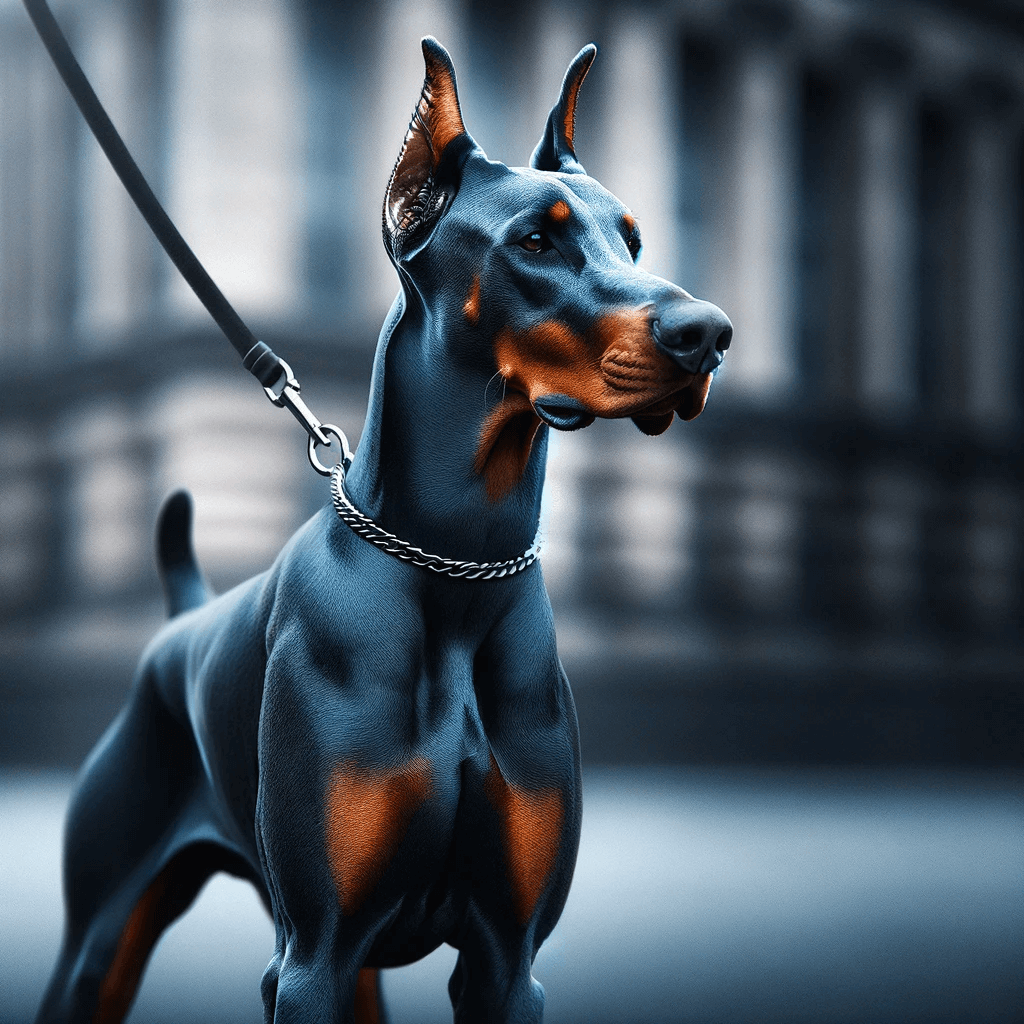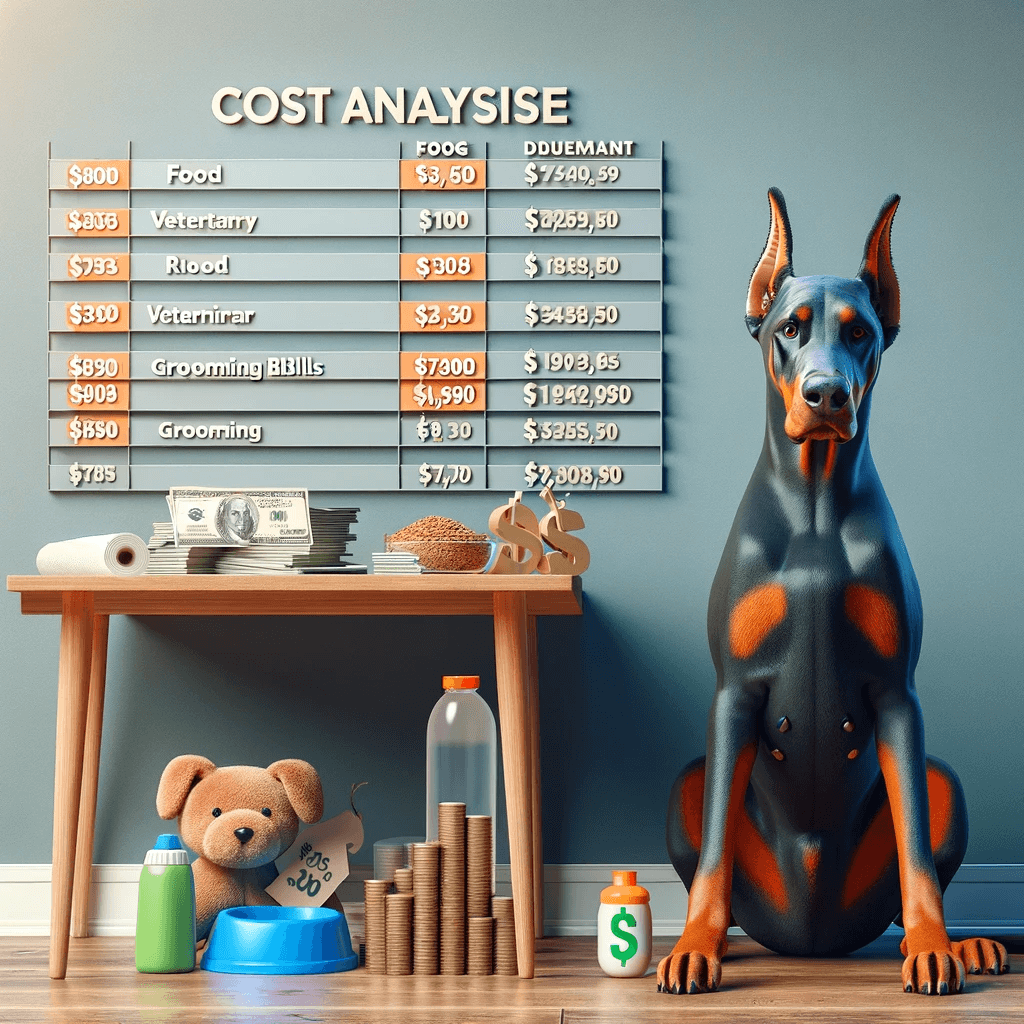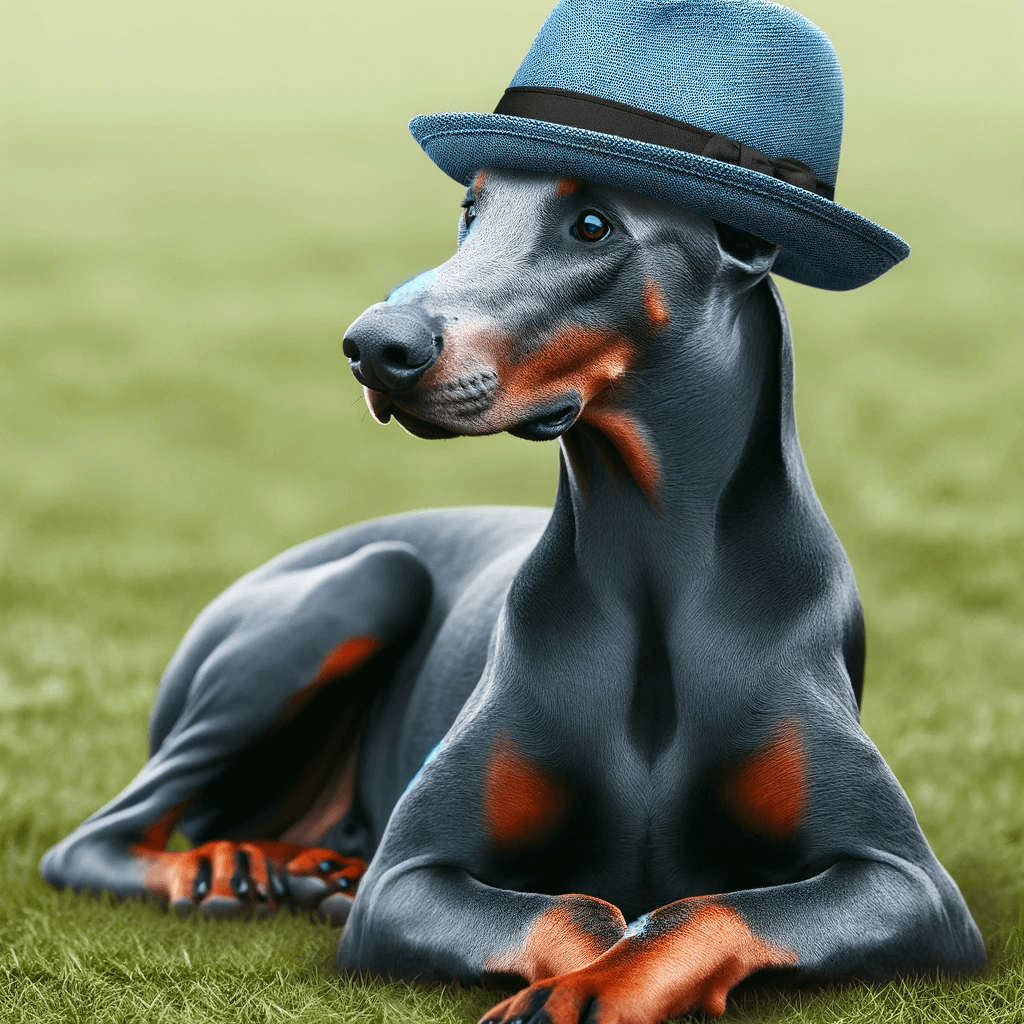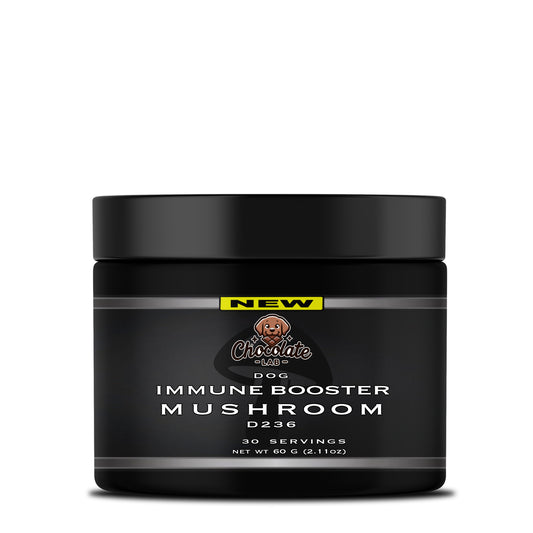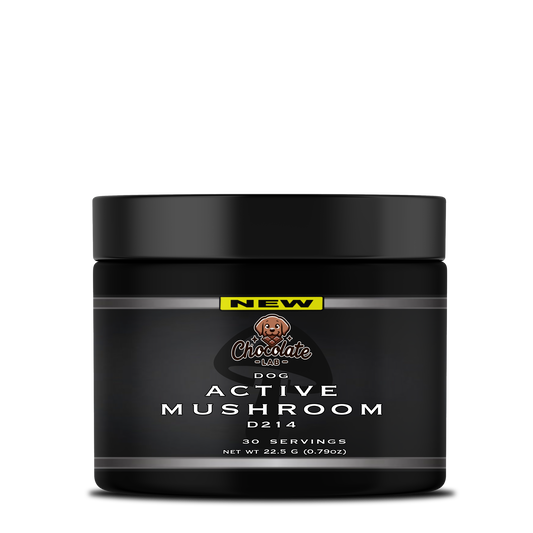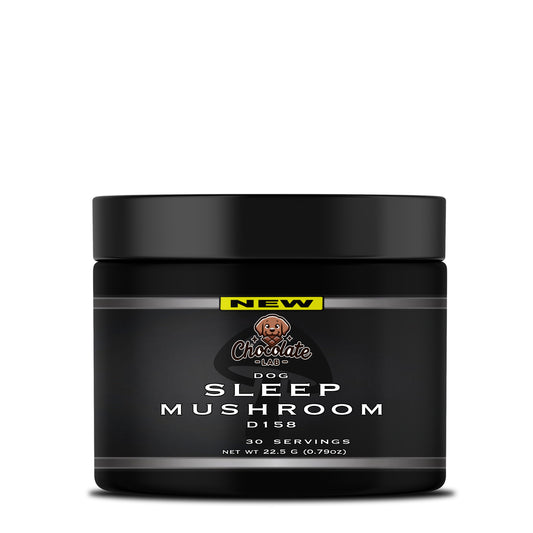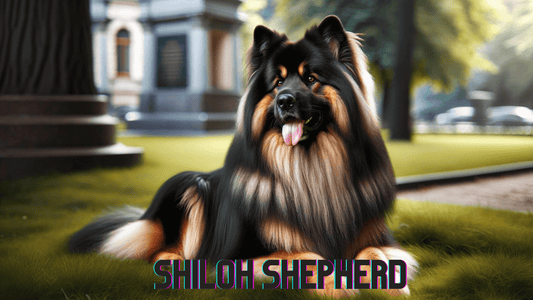Embark on a journey into the fascinating world of Blue Dobermans! Whether you're an existing owner or contemplating the addition of one of these majestic dogs to your life, this guide serves as your ultimate resource. We'll delve into every facet of life with a Blue Doberman.
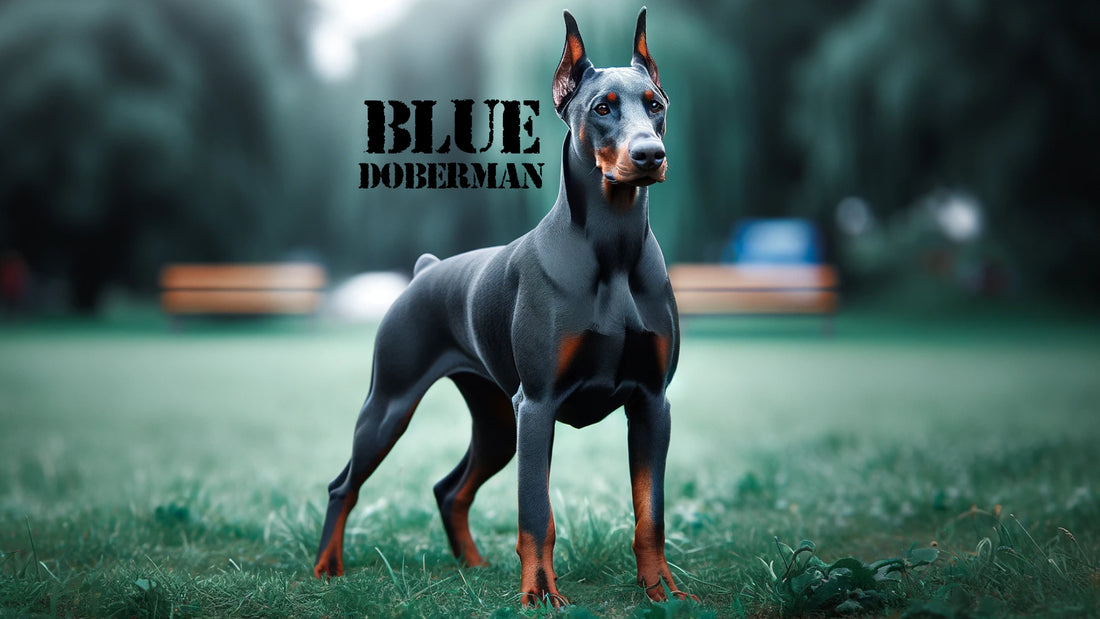
Blue Doberman - Dog Breed Information, Puppies & Expert Tips
Embarking on the Wonders of Blue Dobermans: A Comprehensive Exploration
Published on 02/06/2024, 1:30 PM MST
Last Updated on 02/08/2024, 3:00 AM MST
Comprehensive Guide to Blue Dobermans

| Key Term | Valuable Facts |
|---|---|
| What is a Blue Doberman? | A Blue Doberman is a color variation of the Doberman Pinscher breed, characterized by a unique blue (gray) coat. This coat color is a result of a dilution gene affecting the black pigment, giving the coat a bluish-gray appearance. |
| Coat and Appearance | Blue Dobermans have a short, smooth coat that is blue-gray in color. They possess the same sleek, muscular build as standard Dobermans and often have rust-colored markings on their face, chest, and legs. |
| Breed Characteristics | They retain the standard Doberman traits: intelligence, loyalty, and a strong protective instinct. Blue Dobermans are known for their alertness and make excellent guard dogs and family pets. |
| Temperament | These dogs are energetic, affectionate, and loyal to their families. They are generally good with children and other pets if properly socialized. Early socialization is important to ensure a well-rounded temperament. |
| Exercise Needs | Blue Dobermans are an active breed that requires regular exercise to stay physically and mentally healthy. Activities like running, playing fetch, and agility training are ideal. |
| Grooming Requirements | Their short coat is relatively low maintenance but does require regular brushing to remove loose hair and maintain shine. Bathing should be done as needed. |
| Health Considerations | They can be prone to the same health issues as standard Dobermans, including cardiomyopathy, hip dysplasia, and von Willebrand's disease. Skin issues are more common in Blue Dobermans due to their coat color dilution. |
| Adaptability | Blue Dobermans adapt well to different living situations but thrive in environments where they have space for exercise. They can live in apartments if they are given sufficient physical activity. |
| Training and Discipline | They respond well to consistent, positive training methods. Training should focus on obedience, socialization, and discipline to manage their protective instincts. |
| Lifespan and Size | Blue Dobermans have a lifespan of about 10 to 13 years. They are a large breed, with males generally being larger and more robust than females. |
Table of Content
- Introduction: Exploring the Blue Doberman
- Origins and Genetics of the Blue Doberman
- Physical Characteristics of the Blue Doberman
- Temperament and Behavior of Blue Dobermans
- Training and Exercise Requirements for Blue Dobermans
- Health and Lifespan of Blue Dobermans
- Grooming and Care of Blue Dobermans
- Blue Dobermans in Family and Social Settings
- Comparing Male and Female Blue Dobermans
- Selecting a Blue Doberman Puppy
- Unique Characteristics of Blue Dobermans
- Pros and Cons of Owning a Blue Doberman
- Costs Associated with Blue Dobermans
- Conclusion: The Unique Appeal of Blue Dobermans
- FAQs About Blue Dobermans
Introduction: Exploring the Blue Doberman

The Blue Doberman is a mesmerizing variant of the Doberman Pinscher, known for its unique coat color that ranges from a soft charcoal to a shimmering steel blue. This distinctive appearance is the result of a genetic trait and sets the Blue Doberman apart in the world of canine breeds. Beyond their stunning blue coat, these dogs are cherished for their loyal, intelligent, and protective nature, making them a popular choice among dog enthusiasts. The Blue Doberman holds a special allure due to its less common appearance, attracting attention and curiosity. As a color variation of the Doberman Pinscher, they share many of the breed's well-known characteristics, such as a strong physique, alertness, and a keen sense of loyalty. This introduction aims to shed light on the Blue Doberman's unique features, temperament, and the special considerations needed for their care, particularly focusing on maintaining the health and beauty of their distinctive blue coat.
- Defining the Blue Doberman: A unique color variation of the Doberman Pinscher breed.
- Characteristic Features: Notable for their blue-tinted coat, intelligence, and protective nature.
- Rising Popularity: Increasing interest and appeal among dog lovers and enthusiasts.
Blue Doberman Overview
| Feature | Description |
|---|---|
| Coat Color | Unique blue sheen |
| Temperament | Intelligent, loyal, protective |
| Physical Attributes | Strong, athletic build |
Quick Tips for Potential Owners
🐾 Coat Care Importance: Special attention to coat health and grooming.
🐾 Understanding the Breed: Recognizing the unique needs and traits of the Blue Doberman.
Origins and Genetics of the Blue Doberman

The Blue Doberman's origin is rooted in the same history as the standard Doberman Pinscher, a breed developed in Germany in the late 19th century. The blue coat color is a result of a specific genetic mutation that affects the pigmentation in the dog's fur. This variation, while not initially part of the breed's standard, has gained recognition and appreciation over time. Understanding the genetics behind the blue coloration is important for prospective owners, as it can come with specific health considerations. The Blue Doberman shares the breed's history of being a loyal guardian and an agile working dog. This section delves into the genetic factors contributing to the blue coat color and explores how the Blue Doberman has been embraced within the broader context of the breed's rich heritage.
- Breed History: Tracing the roots of the Doberman Pinscher breed.
- Genetic Basis for Blue Coloration: Exploring the genetics behind the unique coat color.
- Recognition of Blue Variation: The emergence and acceptance of the Blue Doberman in the breed's lineage.
- Discover the allure of unique coat colors in dog breeds by exploring the striking appearance of the Blue German Shepherd, which shares the rare color trait with the Blue Doberman.
Genetic Lineage of the Blue Doberman
| Historical Aspect | Description |
|---|---|
| Breed Origins | Developed in Germany, late 19th century |
| Genetic Mutation | Responsible for blue coat coloration |
| Breed Acceptance | Inclusion of blue variation in breed standards |
Quick Tips for Understanding Genetics
🐾 Research the Lineage: Gain insights into the breed's background and blue color genetics.
🐾 Health Awareness: Be informed about specific health issues linked to the blue coat color.
🐾 Breed Appreciation: Value the Blue Doberman's unique place within the Doberman Pinscher lineage.
Physical Characteristics of the Blue Doberman

The physical characteristics of the Blue Doberman are both striking and admirable. This variant maintains the traditional Doberman's robust and athletic build but is distinguished by its unique coat color. The blue hue is not just a simple color; it comes with a shimmering sheen that varies in intensity and can appear different under various lighting conditions. Grooming this unique coat requires special attention to maintain its luster and health. In terms of size, the Blue Doberman matches the standard Doberman, featuring a strong, muscular physique indicative of their agility and strength. It's important to note that while their coat is their most notable feature, it doesn't affect their physical abilities or temperament. The Blue Doberman is as capable and versatile as any standard Doberman, excelling in roles such as guarding, companionship, and agility. Understanding and appreciating these physical attributes is crucial for potential owners, as it helps in understanding the breed's needs and ensuring their well-being.
- Coat Texture and Color: Unique blue sheen, varying in intensity.
- Size and Build: Robust, muscular, and athletic, typical of Dobermans.
- Distinctive Physical Features: Shimmering blue coat that sets them apart.
- The Lilac French Bulldog article delves into the genetics behind distinctive coat colors, offering insights that fans of uniquely colored breeds like the Blue Doberman will find fascinating.
Physical Comparison of Blue Dobermans
| Trait | Blue Doberman | Standard Doberman |
|---|---|---|
| Coat Color | Unique blue with varying sheen | Typically black, red, or fawn |
| Size and Build | Similar to standard Doberman | Muscular, strong, and agile |
| Physical Abilities | Comparable to other Dobermans | High agility and strength |
Quick Tips for Physical Care
🐾 Regular Grooming: Essential for maintaining the health and appearance of the blue coat.
🐾 Exercise Needs: Ensure they get enough physical activity to match their energetic nature.
🐾 Health Check-Ups: Regular veterinary visits for overall physical well-being.
Temperament and Behavior of Blue Dobermans

The temperament and behavior of Blue Dobermans are key aspects of their personality and closely mirror those of the standard Doberman Pinscher. Known for their loyalty and intelligence, Blue Dobermans make excellent companions and guardians. They are often alert, responsive, and exhibit a protective nature towards their family. Despite their guarding instincts, with proper socialization, they can be gentle and affectionate, making them suitable for family settings. Their intelligence makes them highly trainable, and they respond well to positive reinforcement techniques. Blue Dobermans are known for their energy and require mental stimulation to prevent boredom. Their adaptability allows them to thrive in various environments, from active family homes to working roles. Understanding and nurturing these behavioral traits from a young age are crucial in developing a well-rounded and sociable Blue Doberman.
- Loyalty and Intelligence: Key traits of their temperament.
- Protective Nature: Strong guarding instincts balanced with proper training.
- Family Compatibility: Can be affectionate and gentle in family environments.
- Training and Socialization: Crucial for their behavioral development.
- Our Exotic Bully piece explores the world of specialized dog breeds, highlighting the appeal of unique physical traits that are similarly celebrated in the Blue Doberman.
Behavior Traits Comparison
| Trait | Blue Doberman | General Doberman Traits |
|---|---|---|
| Loyalty | Highly loyal to their family | Known for strong loyalty |
| Intelligence | Very intelligent and trainable | Smart and responsive to training |
| Family Compatibility | Good with proper socialization | Typically good with families |
Quick Tips for Temperament Nurturing
🐾 Consistent Training: Establish a training regimen to harness their intelligence and loyalty.
🐾 Early Socialization: Expose them to different environments and people from a young age.
🐾 Mental Stimulation: Engage them in activities that challenge their intellect.
Training and Exercise Requirements for Blue Dobermans

Blue Dobermans, like all Dobermans, are known for their impressive physique, intelligence, and energy. These traits necessitate a comprehensive approach to their training and exercise routines. Adequate physical exercise and mental stimulation are not merely beneficial; they are essential for maintaining the health, happiness, and overall well-being of a Blue Doberman. Here's a closer look at what is required to meet the needs of this dynamic breed:
Physical Exercise Needs
- Daily Exercise: Blue Dobermans require significant daily exercise to maintain their physical fitness and mental health. At least 1 to 2 hours of physical activity per day is recommended, which can include jogging, brisk walking, and play sessions in a securely fenced area.
- Agility Training: This breed excels in agility training, which not only provides them with the physical exercise they need but also offers mental challenges. Agility courses that involve running, jumping, and navigating obstacles are particularly beneficial.
Training
- Consistent and Structured Training: Blue Dobermans respond well to training that is consistent and structured. They are quick learners but require clear boundaries and expectations from their owners. Training should be based on positive reinforcement, rewarding good behavior to encourage repetition.
- Early Socialization: Introducing your Blue Doberman to a variety of people, animals, and environments at an early age is crucial. Socialization helps prevent the development of fear-based behaviors and aggression, making your dog well-adjusted and confident.
Mental Stimulation
- Obedience Training: Engaging your Blue Doberman in regular obedience training sessions keeps their mind active and reinforces their training. Teaching commands and tricks provides mental stimulation and strengthens the bond between you and your dog.
- Puzzle Toys: Puzzle toys and interactive games that challenge their problem-solving skills can keep them mentally stimulated and prevent boredom.
Behavioral Development
- Preventing Behavioral Issues: Adequate exercise and mental stimulation are key to preventing common behavioral issues in Blue Dobermans, such as anxiety, destructiveness, and excessive barking. A well-exercised and mentally engaged Doberman is more likely to be calm and well-behaved.
- Bonding Through Activity: Activities that involve both physical and mental engagement are excellent opportunities for bonding. They help establish trust and mutual respect between the dog and the owner, forming the foundation of a healthy relationship.
- Learn about the majestic Brindle Cane Corso, whose powerful presence and distinctive coat patterns might appeal to those drawn to the striking looks of the Blue Doberman.
In summary, meeting the training and exercise requirements of a Blue Doberman requires dedication and commitment from the owner. By providing your dog with the physical exercise, training, and mental stimulation they need, you can ensure your Blue Doberman is not only a loyal and protective companion but also a happy and well-adjusted member of your family. Regular activity and engagement are crucial for their development and contribute significantly to their quality of life.
Exercise and Training Schedule
| Day | Activity |
|---|---|
| Monday | Morning jog, basic obedience training |
| Tuesday | Fetch play, agility exercises |
| Wednesday | Long walk, scent tracking games |
| Thursday | Playtime at the dog park, socialization |
| Friday | Advanced training commands, puzzle toys |
| Weekend | Hiking, family activities, rest |
Quick Tips for Effective Training and Exercise
🐾 Routine Establishment: Set a consistent schedule for exercise and training sessions.
🐾 Variety in Activities: Incorporate different types of physical and mental exercises to keep them engaged.
🐾 Bonding Through Training: Use training sessions as an opportunity to strengthen your bond with your Blue Doberman.
Health and Lifespan of Blue Dobermans

When it comes to the health and lifespan of Blue Dobermans, there are several important factors to consider. Typically robust and hardy, these dogs are generally healthy, but like all breeds, they are prone to certain genetic health conditions. Owners should be particularly vigilant about skin issues, as the blue coat can be more susceptible to skin conditions. Regular veterinary check-ups are essential to monitor their health and address any concerns promptly. A balanced diet and regular exercise play a significant role in maintaining their health and longevity. Factors such as genetics, environment, and overall care greatly influence their lifespan. Preventative care, including routine vaccinations and health screenings, is key to ensuring a long and healthy life for a Blue Doberman. Understanding these health considerations and being proactive in healthcare can help maximize the time you have with these magnificent dogs.
- Health Challenges: Awareness of breed-specific health issues, especially skin conditions related to the blue coat.
- Lifespan Expectancy: Typically ranges from 10 to 12 years, depending on health and lifestyle.
- Preventative Healthcare: Importance of regular vet visits, vaccinations, and screenings.
- The elegance of the White Cane Corso is showcased in our article, contrasting beautifully with the rare blue hue of the Doberman and illustrating the diverse beauty within dog breeds.
Healthcare Checklist
| Health Aspect | Consideration |
|---|---|
| Regular Check-ups | Essential for early detection of issues |
| Diet and Nutrition | Balanced diet for optimal health |
| Exercise | Regular activity for physical well-being |
| Skin Care | Special attention to coat and skin health |
Quick Tips for Health Maintenance
🐾 Routine Vet Visits: Schedule regular check-ups to monitor health and catch any issues early.
🐾 Balanced Diet: Provide a diet that supports their size and energy levels.
🐾 Active Lifestyle: Ensure they get enough exercise to maintain their physical health.
Grooming and Care of Blue Dobermans

Grooming is a vital aspect of caring for a Blue Doberman, especially given their distinctive coat. Regular grooming not only keeps their coat clean and healthy but also helps in the early detection of skin issues, which blue-coated Dobermans can be prone to. Their coat requires frequent brushing to remove loose fur and prevent matting. Bathing should be done as needed, using gentle shampoos to maintain the coat's health and sheen. Apart from coat care, routine nail trimming, ear cleaning, and dental care are crucial for their overall well-being. A well-groomed Blue Doberman not only looks magnificent but is also a healthier and happier dog. Establishing a consistent grooming routine will make the process easier for both the dog and the owner, and provides an excellent opportunity for bonding.
- Grooming Requirements: Regular brushing and bathing are key to maintaining the health of their blue coat.
- Nutritional Needs: A well-balanced diet contributes to a healthy coat and overall well-being.
- General Care Tips: Includes dental, nail, and ear care.
- Delve into the charm of the Black French Bulldog, a breed that, like the Blue Doberman, captivates enthusiasts with its distinctive coloration and charismatic personality.
Grooming and Care Schedule
| Grooming Task | Frequency |
|---|---|
| Brushing | Several times a week |
| Bathing | As needed, depending on activity level |
| Nail Trimming | Monthly or as required |
| Dental Care | Daily brushing or use of dental treats |
Quick Tips for Efficient Grooming
🐾 Proper Brushing: Use the right type of brush for their coat to effectively remove tangles and loose hair.
🐾 Regular Bathing: Bathe them as necessary, using a shampoo suitable for their coat type.
🐾 Health Checkups During Grooming: Use grooming time to check for any signs of health issues or skin problems.
Blue Dobermans in Family and Social Settings

Integrating a Blue Doberman into family and social settings requires understanding and adaptation from both the dog and its human companions. Known for their loyalty and protective nature, these dogs can be excellent family pets, forming strong bonds with their human family members. They typically exhibit a calm and confident demeanor in social settings, though early and consistent socialization is crucial to develop these traits. Blue Dobermans are generally good with children, showing patience and gentleness, but interactions should always be supervised, especially with younger children. Their behavior around other pets can vary; while many are friendly and tolerant, individual socialization experiences play a significant role. These dogs thrive in an environment where they feel like part of the family, with clear boundaries and consistent routines. Proper socialization from a young age helps them adjust well to different situations and prevents overly protective behaviors.
- Family Compatibility: Loyal and protective, making them great family pets.
- Interaction with Children and Pets: Generally good, but requires proper socialization and supervision.
- Socialization Needs: Essential for their behavioral development and adaptability.
- The Rottweiler Lab Mix article offers insights into the world of mixed breeds, highlighting the blend of traits that can appeal to those interested in the unique characteristics of the Blue Doberman.
Family and Social Compatibility Assessment
| Environment | Suitability |
|---|---|
| Family Home | High, with proper training and exercise |
| With Children | Good, when supervised and properly socialized |
| With Other Pets | Variable, based on individual socialization |
Quick Tips for Social Integration
🐾 Consistent Socialization: Introduce them to various people and settings from an early age.
🐾 Supervised Interactions: Always supervise interactions with children and other pets.
🐾 Routine and Boundaries: Establish a clear routine and boundaries to help them feel secure and integrated.
Comparing Male and Female Blue Dobermans

The differences between male and female Blue Dobermans can influence your decision when choosing a pet. Generally, males tend to be larger and more robust, displaying a more assertive demeanor. Females, on the other hand, might be slightly smaller and can exhibit more independent traits. However, these are general tendencies and individual personalities can vary greatly. Both genders showcase the breed's characteristic loyalty and intelligence. In terms of health, both sexes require the same level of care, though females may have specific needs related to reproductive health. The choice between a male or female should be based on individual preferences and compatibility with the owner's lifestyle, along with consideration for their ability to manage and train the dog effectively.
- Behavioral Tendencies: Males may show more dominance, females might be more independent.
- Physical Differences: Males are often larger than females.
- Health and Temperament Considerations: Similar general health needs, with reproductive health considerations for females.
- Our Red Rottweiler piece uncovers the allure of rare coat colors in traditionally black and tan breeds, paralleling the fascination with the Blue Doberman's unique blue coat.
Male vs. Female Characteristics
| Trait | Male | Female |
|---|---|---|
| Size | Larger and more muscular | Slightly smaller and more refined |
| Behavior | May exhibit more assertive traits | Often show more independence |
| Health Considerations | General health needs similar for both | Additional reproductive health considerations for females |
Quick Tips for Gender Selection
🐾 Lifestyle Match: Consider the dog's size and temperament in relation to your living situation and experience.
🐾 Training Needs: Both genders benefit from early training and socialization, but individual needs may vary.
🐾 Long-Term Commitment: Choosing a dog is a long-term commitment; understanding gender differences can aid in making a well-informed choice.
Selecting a Blue Doberman Puppy

When selecting a Blue Doberman puppy, it's crucial to focus on ethical breeding practices and the health of the puppy. Choosing a puppy from a reputable breeder who prioritizes the health and well-being of their dogs is vital. A responsible breeder will be transparent about their breeding practices and provide health clearances for both the puppy's parents and the puppy itself. They should also be knowledgeable about the specific needs and characteristics of the Blue Doberman. Prospective owners should observe the puppy's behavior; a healthy puppy should be alert, playful, and responsive. It's also important to assess the environment in which the puppies are raised, as this can impact their early socialization and development. Choosing a responsible breeder not only ensures you get a healthy and well-socialized puppy but also supports ethical breeding practices that contribute to the breed's overall health and longevity.
- Reputable Breeders: Choose breeders who are transparent and responsible in their practices.
- Health Documentation: Ensure the breeder provides health clearances and vaccination records.
- Puppy Behavior: Look for signs of good health and temperament in the puppy.
- Explore the Doberman Lab Mix, a hybrid that combines the best of both parent breeds, offering a perspective on the versatility and appeal of mixing breeds, much like the purebred allure of the Blue Doberman.
Breeder Evaluation Criteria
| Criteria | What to Look For |
|---|---|
| Health Clearances | Proof of genetic testing and vaccinations |
| Breeding Practices | Ethical, responsible breeding |
| Puppy Environment | Healthy, clean, and socially enriching |
Purchasing Insights for Prospective Owners
🐾 Inquire Thoroughly: Ask the breeder detailed questions about the puppy's health, temperament, and lineage.
🐾 Visit Breeding Facility: If possible, visit the place where the puppies are raised to observe their living conditions and interactions.
🐾 Essential Documentation: Make sure to obtain all necessary health documents and information about the puppy's early care and diet.
Unique Characteristics of Blue Dobermans

The Blue Doberman stands out not only for its unique coat color but also for its distinct breed-specific features. This rare variant retains all the traditional qualities of the Doberman Pinscher, such as high intelligence, agility, and a strong work drive, but with the added allure of its blue coat. This coat color can sometimes give the impression of a more intimidating appearance, which can be an advantage in certain working roles. They also tend to have a strong presence and command attention, both in the field and as family pets. Their intelligence and trainability make them suitable for a variety of tasks and roles, from personal protection to competitive sports. It's important to remember that despite their unique appearance, they share the same needs as standard Dobermans in terms of training, exercise, and socialization. The Blue Doberman is a testament to the breed's versatility and adaptability, offering all the qualities of the standard Doberman with a visually striking twist.
- Breed-Specific Features: Retains traditional Doberman traits with the unique addition of a blue coat.
- Comparison with Standard Dobermans: Similar in temperament and ability, with the distinction of coat color.
- Unique Skills and Capabilities: Equally capable in various roles, with a potentially more imposing appearance.
- The Boxador article introduces readers to another captivating mixed breed, providing a glimpse into the possibilities of combining distinctive traits, akin to the singular beauty of the Blue Doberman.
Characteristic Overview
| Feature | Description |
|---|---|
| Coat Color | Distinctive glossy blue |
| Intelligence | High, with strong problem-solving skills |
| Work Compatibility | Suitable for a variety of working roles |
Engaging Trivia for Enthusiasts
🐾 Versatility in Roles: Their impressive presence and capabilities make them suitable for diverse roles, from law enforcement to family companions.
🐾 Distinct Appearance: The blue coat adds a unique aesthetic, making them stand out in any setting.
🐾 Strong Character: Known for their strong personality and presence, they command respect and admiration.
Pros and Cons of Owning a Blue Doberman

Owning a Blue Doberman comes with a unique set of pros and cons that potential owners should consider. On the plus side, their striking appearance and rare coat color make them stand out, which can be a source of pride for owners. They are highly intelligent and trainable, making them excellent for various work roles and an active family life. Their loyalty and protective nature make them great companions and guardians. However, their high energy levels and need for regular exercise and mental stimulation can be challenging for those who lead a more sedentary lifestyle. They also require consistent training and socialization from an early age to prevent behavioral issues. Their rarity might also mean a higher purchase price and potentially higher costs for specific care needs. Understanding these pros and cons is essential for anyone considering adding a Blue Doberman to their family.
- Benefits: Unique appearance, intelligence, loyalty.
- Challenges: High exercise and training needs, potential for higher costs.
- Delving into the Blue Cane Corso, our article highlights another breed known for its rare coat color, drawing parallels to the Blue Doberman and the shared interest in blue-coated breeds.
Pros & Cons Analysis
| Aspect | Pros | Cons |
|---|---|---|
| Appearance | Unique, striking blue coat | None |
| Intelligence | Highly trainable and adaptable | Requires consistent mental stimulation |
| Exercise Needs | Great for active lifestyles | Not suited for sedentary owners |
| Cost | Rare breed, potentially higher value | Higher initial and potential ongoing costs |
Ownership Considerations: Making an Informed Decision
🐾 Assess Lifestyle Fit: Ensure your lifestyle can accommodate their high energy and training needs.
🐾 Budgeting for Costs: Be prepared for the financial commitment, including potential higher costs for care.
🐾 Long-Term Commitment: Owning a Blue Doberman is a long-term commitment that requires time, energy, and resources.
Costs Associated with Blue Dobermans

Owning a Blue Doberman involves various costs that should be carefully considered. The initial cost can be significant, especially when purchasing from a breeder specializing in this rare variant. Ongoing expenses include high-quality food, routine veterinary care, grooming, and possibly higher costs for specific health needs. Additional costs might include training classes, specialized equipment, and insurance. The financial commitment can be substantial, but for many owners, the unique companionship and capabilities of this breed are well worth the investment. Prospective owners should plan and budget for these expenses to ensure a fulfilling and stress-free life for both the dog and themselves.
Initial Acquisition Costs
Purchasing a Blue Doberman from a reputable breeder is the first step in your journey. The rarity of the Blue Doberman's coat color means that you might have to pay a premium price for this specific variant.
Ongoing Expenses: A Closer Look
Your Blue Doberman's well-being hinges on regular care that includes high-quality food, routine veterinary visits, and grooming essentials. These costs can add up quickly, so it's crucial to understand what you're getting into.
Extra Costs: Beyond the Basics
Beyond the basics, you might opt for specialized training to harness your Doberman's capabilities fully. Additionally, investing in quality equipment and insurance can safeguard against unexpected health issues and accidents.
Detailed Cost Breakdown for Blue Dobermans
Here's a detailed table breaking down the costs associated with owning a Blue Doberman:
| Expense Category | Estimated Cost (USD) | Notes |
|---|---|---|
| Initial Purchase | $1,500 - $2,500 | Price varies by breeder and lineage. |
| High-Quality Food | $60 - $100/month | Depends on brand and dog size. |
| Routine Veterinary Care | $200 - $600/year | Includes vaccines and regular check-ups. |
| Grooming | $30 - $90/session | Frequency depends on personal preference. |
| Training Classes | $50 - $200/class | Optional but recommended. |
| Specialized Equipment | $100 - $500 | Includes leashes, beds, and crates. |
| Insurance | $30 - $70/month | Varies by coverage level and provider. |
| Emergency Veterinary Costs | $200 - $2,000+ | For unexpected illnesses or injuries. |
| Miscellaneous | $50 - $200/year | Toys, treats, and other supplies. |
| Total Annual Care (excluding initial purchase) | $2,720 - $5,360+ | Excludes unforeseen expenses. |
Financial Management Tips for Owners
🐾 Effective Budgeting: Plan for both initial and ongoing expenses to avoid financial strain.
🐾 Cost-Saving Strategies: Look for ways to save on supplies and care without compromising quality.
🐾 Insurance Options: Consider pet insurance to help cover unexpected healthcare costs.
Conclusion: The Unique Appeal of Blue Dobermans

Choosing a Blue Doberman can be a rewarding decision for those who appreciate the breed's unique traits and are prepared for the responsibilities that come with owning such a dynamic dog. They are particularly suited to individuals or families who lead an active lifestyle and are willing to invest time in training and exercise. Their striking blue coat and rarity add an element of uniqueness to their already impressive capabilities as a working dog and loyal companion. However, prospective owners should carefully consider the time, effort, and financial commitment involved in raising a Blue Doberman. If you're prepared for the challenges and are looking for a smart, loyal, and protective dog, then the Blue Doberman could be the perfect addition to your life.
- Suitability for Active Lifestyles: Ideal for those who can provide adequate exercise and engagement.
- Unique Characteristics: The rare blue coat and the breed's capabilities offer a unique pet ownership experience.
- Commitment Requirements: High level of commitment needed in terms of time, training, and finances.
Summary of Key Insights
| Consideration | Description |
|---|---|
| Appearance and Rarity | Unique and striking blue coat |
| Intelligence and Trainability | High, suitable for various roles |
| Lifestyle Fit | Best suited for active owners and families |
Final Recommendations for Potential Owners
🐾 Evaluate Compatibility: Make sure a Blue Doberman fits your lifestyle and capabilities.
🐾 Prepare for Responsibilities: Be ready for the training, exercise, and financial commitments involved.
🐾 Embrace the Journey: Enjoy the unique experience and companionship that a Blue Doberman offers.
FAQs About Blue Dobermans

Top 15 Questions About Blue Dobermans
| Question | Answer |
|---|---|
| What is unique about the Blue Doberman's coat? | Its blue sheen is due to a genetic trait. |
| Are Blue Dobermans different in temperament? | Similar to standard Dobermans, but individual personalities vary. |
| What are the exercise needs of a Blue Doberman? | High; they require daily physical and mental stimulation. |
| How do I groom a Blue Doberman? | Regular brushing and occasional bathing with gentle products. |
| Are Blue Dobermans good with children? | Yes, with proper training and socialization. |
| What health issues should I be aware of? | Skin issues and standard Doberman-related health concerns. |
| How long do Blue Dobermans live? | Typically 10-12 years, depending on their health and care. |
| Is the Blue Doberman a good family dog? | Yes, they are loyal and protective, making them great family pets. |
| How much does a Blue Doberman puppy cost? | Prices vary, generally higher due to their rarity. |
| What should I look for in a Blue Doberman breeder? | Ethical practices, health clearances, and a focus on the breed's well-being. |
| How do I train a Blue Doberman? | Consistently, with positive reinforcement techniques. |
| Can Blue Dobermans live in apartments? | Yes, if they receive enough exercise and mental stimulation. |
| How often do Blue Dobermans need to be groomed? | Regular brushing, with baths as needed. |
| What is the best diet for a Blue Doberman? | Balanced diet appropriate for their age, size, and activity level. |
| Are male or female Blue Dobermans better for first-time owners? | Gender doesn't significantly affect suitability; individual temperament is more important. |

